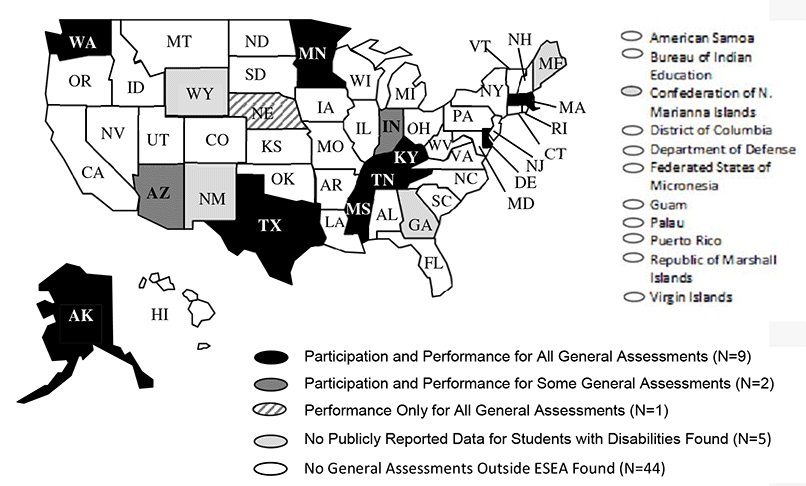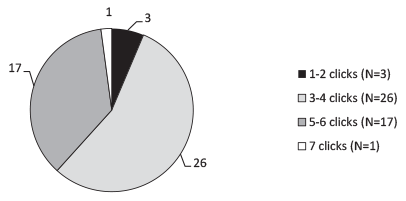Technical Report 692011-12 Publicly Reported Assessment Results for Students with Disabilities and ELLs with DisabilitiesDebra Albus, Sheryl S. Lazarus,, Martha L. Thurlow July 2014 All rights reserved. Any or all portions of this document may be reproduced and distributed without prior permission, provided the source is cited as: Albus, D., Lazarus, S. S., & Thurlow, M. L. (2014). 2011-12 Publicly reported assessment results for students with disabilities and ELLs with disabilities (Technical Report 69). Minneapolis, MN: University of Minnesota, National Center on Educational Outcomes. Table of ContentsExecutive SummaryThis is the fifteenth report by the National Center on Educational Outcomes (NCEO) that analyzes public reporting practices for assessment data for students with disabilities in K-12 schools in the United States. The Individuals with Disabilities Education Act (IDEA) and the Elementary and Secondary Education Act (ESEA) require states to disaggregate participation and performance data at the state level. The ESEA flexibility waivers that many states received did not change the requirement for states to report on their report cards, for the "all students" group and for all of the subgroups, including special education, as long as the number of students in a subgroup is equal to or above the minimum reporting number defined by the state. This report presents information on publicly reported participation and performance data for the 50 regular states and the 11 unique states (American Samoa, Bureau of Indian Education, Commonwealth of Northern Mariana Islands, U.S. Department of Defense Education Activities, District of Columbia, Federated States of Micronesia, Guam, Palau, Puerto Rico, Republic of the Marshall Islands, and U.S. Virgin Islands). For the 2011-12 school year, 49 of the 61 states reported participation and performance data for students with disabilities for all general assessments within the ESEA accountability system. Fifty-one states reported participation and performance data for alternate assessments based on alternate achievement standards (AA-AAS) that were within the ESEA system. Information about state assessments outside of ESEA is also presented. This report also includes information on public reporting for English Language Learners (ELLs) with disabilities. Only seven states reported both participation and performance for the general assessment for this group. More states (N=21) reported both participation and performance data for ELLs with disabilities on the AA-AAS. Most states reported some participation and performance data by individual grade and test for students with disabilities, though a few only reported data that merged grades or tests. Thirty-nine of the regular states reported student performance by achievement level, and 34 reported the percent proficient. This report also presents the results of an analysis of the ease of finding publicly reported data for students with disabilities on states' department of education websites. This involved counting the number of mouse clicks that it took to arrive at public reports for students with disabilities on the general assessment and AA-AAS. For 30 of the regular states it took 3-4 clicks to arrive at the general assessment data; 5 or more clicks were required for 13 states. For AA-AAS data, 26 regular states required 3-4 clicks; 5 or more clicks were required for 17 states. The public reporting of data is, and will continue to be, an important part of accountability for states. This is particularly the case as states transition to new assessments based on common core standards. The following recommendations are offered for public reporting of disaggregated data for students with disabilities:
Top of Page | Table of Contents OverviewUnder the Individuals with Disabilities Education Act (IDEA) and the Elementary and Secondary Education Act (ESEA), states are required to report Reading, Mathematics, and Science assessment data to the federal government for all students and for student subgroups. They are also to report these data for the general public. Public reporting found online includes school "report cards," state assessment reports, and customized reports on state education websites (Albus & Thurlow, 2013). Additionally, the ESEA flexibility waivers that many states received continue to require states to report on their report cards, for the "all students" group and for all of the subgroups, including special education (U.S. Department of Education, 2013). The purpose of this report is to analyze the extent to which states report data for students with disabilities "to the public with the same frequency and in the same detail as it reports on the assessment of nondisabled children," as required by IDEA (Wiley, Thurlow, & Klein, 2005). The report describes how states report participation and performance data to the public, with some analyses focusing on average performance gaps across years. It also summarizes the extent of reporting for ELLs with disabilities and the ease of accessing public reporting reports. The National Center on Educational Outcomes (NCEO) has been tracking and analyzing public reporting for the special education subgroup since 1997. The 2010-11 assessment data (Albus & Thurlow, 2013) indicated that the number of states reporting both disaggregated participation and performance data online for students with disabilities on general assessments within accountability systems was 45 states; this was a decrease of one state when compared to the years 2007-08, 2008-09, and 2010-11 (Albus & Thurlow, 2013; Albus, Thurlow, & Bremer, 2009; Thurlow, Bremer, & Albus, 2011). Prior to 2006-07, starting in 2002-03, this count of states ranged between 35 states and 39 states (Albus et al., 2009; Klein, Wiley, & Thurlow, 2006; Thurlow, Bremer, & Albus, 2008; Thurlow & Wiley, 2004; Thurlow, Wiley, & Bielinski, 2003; Wiley, Thurlow, & Klein, 2005; VanGetson & Thurlow, 2007). In 2010-11, the number of states that reported disaggregated participation and performance data for alternate assessments based on alternate achievement standards (AA-AAS) was 48 states. This was an increase from just 44 states reporting data from this assessment in 2008-09. The count had been 36 states from 2006-07 to 2007-08. This number of states reporting alternate assessments based on modified achievement standards (AA-MAS) participation and performance data had been as low as 28 states in 2005-06 and as high as 42 states in 2004-05. Top of Page | Table of Contents MethodIn May 2013, state department of education websites were searched for publicly available reports that disaggregated participation and performance data for students with disabilities for the 2011-12 school year (i.e., state assessment reports, state report cards, and other report formats). APR and Table 6 data were not included in the analysis. States included in the search were the 50 "regular" states as well as 11 "unique" states (American Samoa, Bureau of Indian Education, Commonwealth of Northern Mariana Islands, U.S. Department of Defense Education Activities, District of Columbia, Federated States of Micronesia, Guam, Palau, Puerto Rico, Republic of the Marshall Islands, and U.S. Virgin Islands). Actual participation and performance data were collected, as well as information about how states reported those data. Data collection included all general and alternate assessments within and outside the ESEA accountability system, including those assessments designed for bilingual or English language learners (ELLs) that were either general or alternate assessments. The information gathered about how states reported participation and performance data were then summarized into individual state summary tables for verification. Verification materials were sent to state assessment directors and state directors of special education in July 2013. Twenty-two regular states and one unique state responded to the verification requests. After the verification process was completed, the participation and performance data, as well as information on how states reported those data, were analyzed. Double checks of the data were completed for accuracy. See Appendix A for a sample email sent to the state directors and sample tables used in the verification process. There are many types of assessments that states can give, each serving different purposes. For example, some are given for accountability, while others are for diploma or graduation purposes. Some assessments may serve dual purposes within a state. Although the data collected for this report included all state level administered assessments presented on state websites, this report focuses on how states publicly reported participation and performance data for students with disabilities on general assessments and alternate assessments based on alternate achievement standards. For this analysis the following terms are defined as follows.
This report also provides additional information on alternates based on other standards such as modified achievement standards and grade level achievement standards, but detailed information is not provided about these assessments in this report. Changes in federal policies for reporting to the U.S. Department of Education, as well as our own criteria, which narrowed after 2004-05, likely affected the changes in the numbers of states reporting on the general and AA-AAS assessments. Annual Performance Report (APR) data (and Section 618, Table 6 data) were not counted as publicly reported data after 2004-05 because these data were not reported with the same frequency and detail as public reporting for all students (see Thurlow et al., 2008). Top of Page | Table of Contents ResultsThe results of the analyses are presented in five sections. The first section presents information about how participation and performance data for students with disabilities were reported by states for general and alternate assessments within and outside of the ESEA accountability system, and how these same data were reported for ELLs with disabilities. The second section describes the approaches states used to communicate participation data. The third section describes the approaches states employed to publicly report general assessment performance data. The fourth section presents general assessment performance data at the elementary, middle, and high school levels for reading and mathematics. This section also includes information about average achievement gaps at these school levels in reading and mathematics. The final section provides information about the ease of finding data on state websites. How States Reported Participation and Performance DataGeneral Assessment Data for Students with DisabilitiesFigure 1 shows that 49 of the 61 states reported participation and performance for all general assessments within the ESEA accountability system for students with disabilities. Eighty percent of states reported participation and performance for all general assessments, 5% reported participation and performance for some general assessments, 3% reported participation only for all assessments, and 11% had no publicly reported data. Figure 1. Extent of Reporting of General Assessment Data for Students with Disabilities Within ESEA [N=61]
Figure 2 portrays the participation and performance reporting for the general assessment by state. This map shows that nearly all states had full reporting of participation and performance for students with disabilities on a general assessment within ESEA accountability systems. For details, see Table B-1 in Appendix B. Figure 2. States Reporting 2011-12 Disaggregated Participation or Performance Data for Students with Disabilities on General State Assessments in ESEA Accountability System*
*Note: The figure does not include state APR data. A broad definition was used to determine whether a state had data. States were included if they had any data reported for the assessment (regardless of whether it was only across all grades, by grade range, or for specific grades). States also reported participation and performance for students with disabilities on general assessments outside the ESEA accountability system. Figure 3 shows that of the 17 states that had general assessments outside ESEA, 9 states reported participation and performance data. Forty-four states did not have any general assessments outside of the ESEA accountability system. Figure 3. Extent of Reporting of General Assessment Data for Students with Disabilities Outside ESEA [N=61]
Figure 4 portrays the participation and performance reporting for general assessments outside the ESEA system by state. This map shows that only a few states publicly reported participation and performance for these assessments. For details, see Table B-2 in Appendix B. Figure 4. States Reporting 2011-12 Disaggregated Participation or Performance Data for Students with Disabilities on General Assessments Outside ESEA System*
*Note: States were included if they had any data reported for the assessment (regardless of whether it was only across grades, by grade range, or for specific grades).
Alternate Assessment Based on Alternate Achievement Standards (AA-AAS) Data for Students with DisabilitiesThis section addresses the extent to which states reported participation and performance data for students with disabilities on alternate assessments based on alternate achievement standards (AA-AAS) within the ESEA accountability system. Figure 5 shows that 51 states reported data for the AA-AAS. This represents 84% of the states. Figure 5. Extent of Reporting of AA-AAS Data Within ESEA [N=61]
Figure 6 shows the states that reported participation and performance data for AA-AAS within the ESEA accountability system. The map shows that most states (N=51) publicly reported participation and performance for students with disabilities for these assessments. For details, see Table B-3 in Appendix B. Figure 6. States Reporting 2011-12 Participation or Performance Data for Students with Disabilities on AA-AAS*
*Note: The figure does not include state APR data. A broad definition was used to determine whether a state had data. States were included if they had any data reported for the assessment (regardless of whether it was only across grades, by grade ranges, or for specific grades).
Assessment Data for English Language Learners with DisabilitiesThis section presents information on how states reported participation and performance data for ELLs with disabilities. Like their peers, most ELLs with disabilities take general assessments; a small percentage take an AA-AAS. Figure 7 shows that 52 states did not report participation or performance for ELLs with disabilities on assessments within ESEA. Only seven states reported both participation and performance data for all general assessments. This represents 11% of the states. Figure 7. Extent of States Reporting Data for ELLs with Disabilities Within ESEA [N=61]
Figure 8 shows the states reporting participation and performance data for ELLs with disabilities on general assessments within the ESEA system. This map shows that only a few states publicly reported participation and performance for ELLs with disabilities. For example, seven states reported participation and performance for all general assessments for ELLs with disabilities. For details, see Table B-4 in Appendix B. Figure 8. States Reporting 2011-12 Disaggregated Participation or Performance Data for ELLs with Disabilities on General Assessments Within ESEA Accountability System
For regular assessments outside ESEA, 15 states did not report data for ELLS with disabilities and only 1 state reported both participation and performance data for this population (See Table B-5 in Appendix B for more details). Figure 9 shows that 21 states, or 34% of states, reported data for participation and performance on AA-AAS for ELLs with disabilities. Forty states did not publicly report data for ELLs with disabilities who may have participated in an AA-AAS. Figure 9. Extent of States Reporting AA-AAS Data for ELLs with Disabilities Within ESEA [N=61]
Figure 10 shows the 21 states that reported participation and performance for ELLs with disabilities on the AA-AAS within the ESEA system. This map shows that among the states that reported these data, either states reported both participation and performance or did not report data for either participation or performance. For details, see Table B-6 in Appendix B. Figure 10. States Reporting 2011-12 Disaggregated Participation or Performance Data for ELLs with Disabilities on AA-AAS
Alternate Assessment Based on Modified Achievement Standards (AA-MAS) Data for Students with Disabilities and ELLs with DisabilitiesAlternate assessments based on modified achievement standards (AA-MAS) are an optional assessment within the ESEA accountability system that only some states offer. For students with disabilities, 10 states reported participation and performance data and 2 states reported performance data only in 2011-12. For ELLs with disabilities, 3 states reported both participation and performance for all AA-MAS and 1 state reported these data for some tests. For details, see Table B-7 in Appendix B. Alternate Assessment Based on Grade Level Achievement Standards (AA-GLAS) Data for Students with Disabilities and ELLs with DisabilitiesAccording to publicly available data, one state had an alternate assessment based on grade level achievement standards (AA-GLAS). That state reported participation and performance data for students with disabilities, but did not report data on ELLs with disabilities. For details see Table B-8 in Appendix B.
Communicating Participation in 2011-12States publicly reported participation rate data for students with disabilities in a variety of ways. Figure 11 shows that 36 of the regular and unique states reported these data. Sixteen reported by grade and test. Twenty states merged grades and tests when reporting the data. Seven states reported by grade but merged tests and another seven states reported by test but merged grades. Tests were merged in different ways by states (e.g., merging general and alternate assessments, merging general assessments, or both). Of the 36 states reporting these data, 22 states publicly reported data only one way, while others reported them in multiple ways. For additional details see Table B-9 in Appendix B. Figure 11. Number of States Using Selected Methods to Report Participation Rate
States reported participation data for general assessments in several different ways. Figure 12 shows the approaches taken by states in presenting participation data. Thirty-seven states publicly reported the number of students tested and 36 states reported the percent of students participating in general assessments within the ESEA accountability system. Only three states reported the percent of students with no scores; seven states presented the number of students with no scores. Figure 12 includes data from states that used any method of reporting participation data (i.e., by grade and test, by merging grades and tests, by grade with tests merged, and by test with grades merged). For additional details see Table B-10 in Appendix B. For details about AA-AAS participation see Table B-11 in Appendix B. Figure 12. States Reporting Participation by Students with Disabilities for General Assessments in ESEA Accountability System in 2011-12
Figure 13 shows the participation rates for grade 8 mathematics for those states where this information was reported by grade and test. Of the 16 states that reported these data by grade and test, 10 states reported these data with denominators based on students with disabilities in grade 8. Two of these states (Connecticut and Pennsylvania) had an AA-MAS and reported these data in different ways. For example, Connecticut showed a lower rate for its general mathematics assessment because a percentage of its students with disabilities took an AA-MAS, and because the denominator Connecticut used in calculating the percentage included both students participating in the general assessment and the AA-MAS. Pennsylvania reported its data differently from Connecticut as noted in the Figure 13 footnote. See Table B-12 in Appendix B for a detailed summary of how states reported AA-MAS participation rates. Figure 13. Percentages of Students with Disabilities Participating in Middle School General Math Assessments in Those States with Reported Participation Rates* in 2011-12
*Two states included in this figure had an AA-MAS: Connecticut and Pennsylvania. Pennsylvania reported AA-MAS rates separately. Connecticut's rate here is lower because it was based on a denominator that summed participation for both the general and alternate assessments. A key for state abbreviations is provided in Table B-13 in Appendix B.
General Assessment Performance Approaches for Students with DisabilitiesSimilar to the reporting practices for participation data, states reported performance in several different ways. Figure 14 shows that of 52 states that reported these data, 43 states reported some performance data by grade and test. Eighteen states reported performance by merging grades and merging tests. Nine states reported data either merging tests for one or more grades, or merging grades for one or more tests. Of the states in Figure 14, 27 states publicly reported performance data only one way, while others reported it in multiple ways. For additional details see Table B-14 in Appendix B. Figure 14. Number of States Using Selected Methods to Report Performance Data
States also report performance data in a variety of ways, such as the number or percent in each achievement level, percent proficient or not proficient, and scaled scores. Figure 15 shows that the most common way that states reported performance data was by percent in each achievement level (n=39). The next most frequent way was by percent proficient. This figure includes data from states that used any method of reporting participation data (i.e., by grade and test, by merging grades and tests, by grade with tests merged, and by test with grades merged). For additional details see Table B-15 in Appendix B. For details about AA-AAS performance see Table B-16 in the Appendix. Figure 15. General Assessments Within ESEA: Number of States Reporting Performance Categories for Students with Disabilities in 2011-12
Selected Results of General Assessment Performance for Students with DisabilitiesIn this section the performance of students with and without disabilities is compared for states that reported data for each of three representative grades (e.g., Grade 4, Grade 8, and Grade 10) by content area (i.e., reading, mathematics). Figures 16 to 21 show the gaps between students with disabilities and their comparison peer group. The solid line represents the gap between students with Individualized Educational Programs (IEPs) and the comparison group. The comparison peer group varied by state, with some states reporting the performance of students without IEPs and others reporting the total student population. Because the gaps were affected by whether a state included all students or students without disabilities, we indicate the group used by each state on the horizontal axis with an A if the state included all students and an O if the comparison group for the state was students who do not have IEPs. The students without IEPs group may include students with 504 plans depending on how a state defined its population. Twelve of the fourteen states with AA-MAS are presented in these figures, and so the gaps reported here could also vary based on how those states reported their performance data. States with an AA-MAS are indicated in the figures with a box around the percent proficient number for students with IEPs. Elementary SchoolFigures 16 and 17 present the results for Grade 4. Across the states, the smallest gap between students with IEPs and the comparison group for elementary reading was 5%, and the largest gap was 58%. For elementary mathematics, the gap ranged from 0% to 49%. Figure 16. Percent Proficient for Elementary Reading* 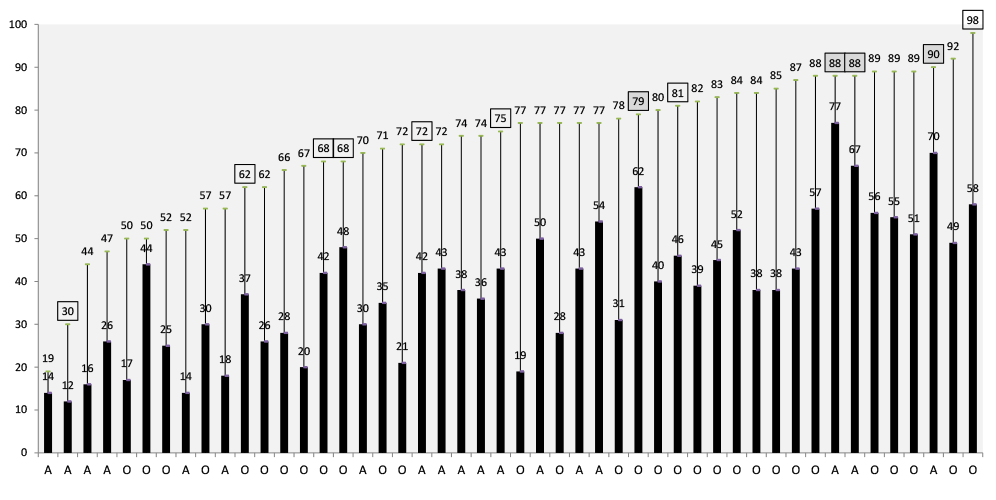 Legend: *Note: N=48 of 61 states (includes unique states); All students=18 states, Students without Disabilities=30, No data=13 states Figure 17. Percent Proficient Elementary Mathematics* 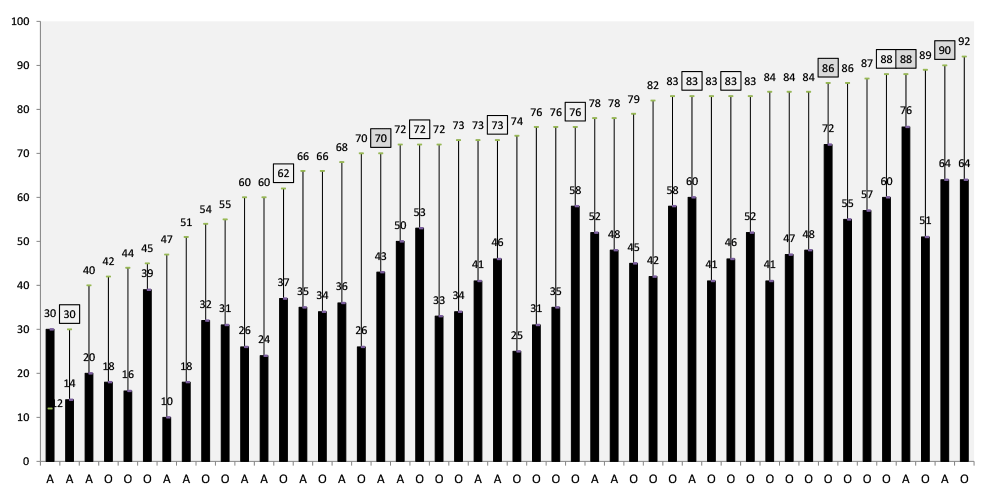 Legend: *Note: N=48 of 61 states (includes unique states); All students=18 states, Students without Disabilities=30, No data=13 states Middle SchoolFigures 18 and 19 show the performance gaps for Grade 8 reading and mathematics. At the middle school level, for reading, gaps ranged from 12% to 54%. For mathematics, the gaps ranged from 11% to 56%. Figure 18. Percent Proficient for Middle School Reading* 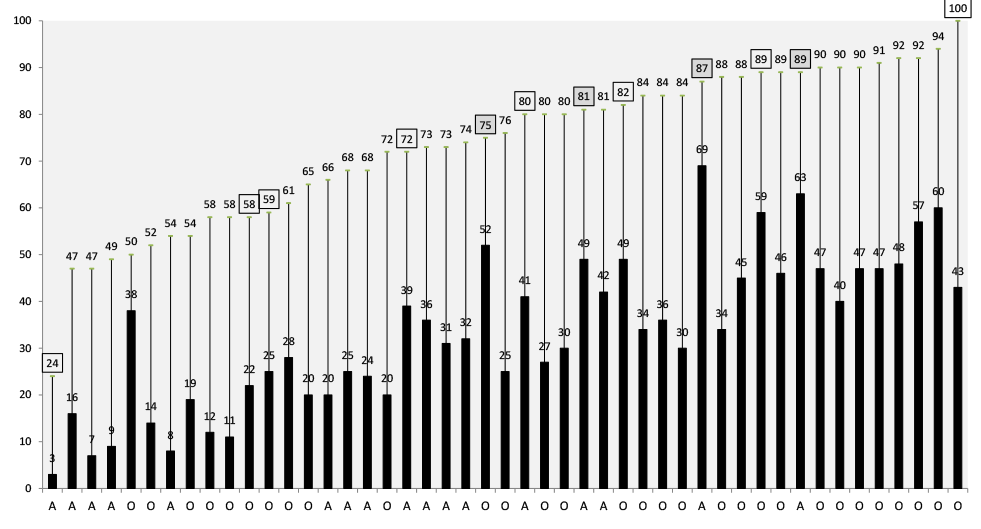 Legend: *Note: N=47 of 61 states (includes unique states); All students=17 states, Students without disabilities=30 states, No data=14 states Figure 19. Percent Proficient for Middle School Mathematics* 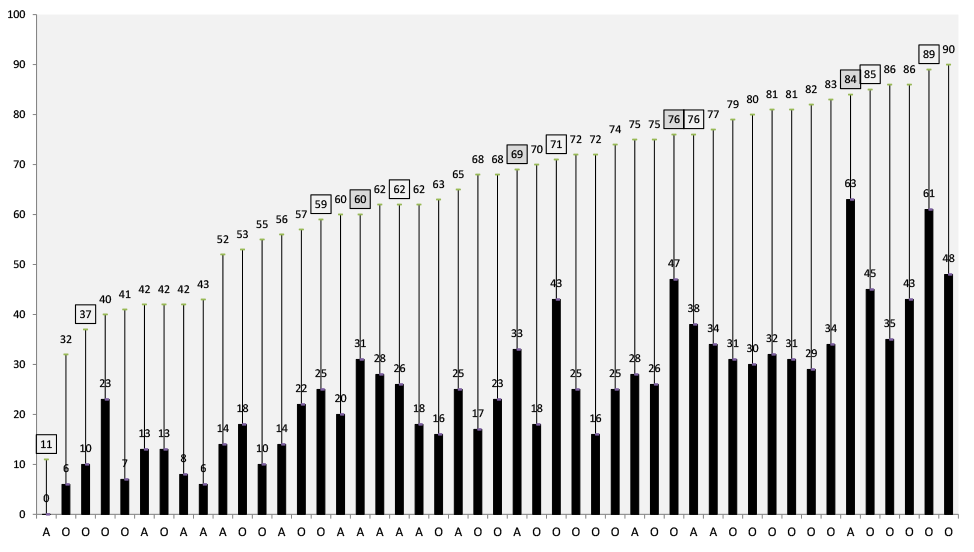 Legend: *Note: N=47 of 61 states (includes unique states); All students=17 states, Students without disabilities=30 states, No data=14 states High SchoolFigures 20 and 21 show gaps for high school reading and mathematics. For reading, the gaps ranged from 5% to 62%; for mathematics the range is from 1% to 56%. Figure 20. Percent Proficient for High School Reading* 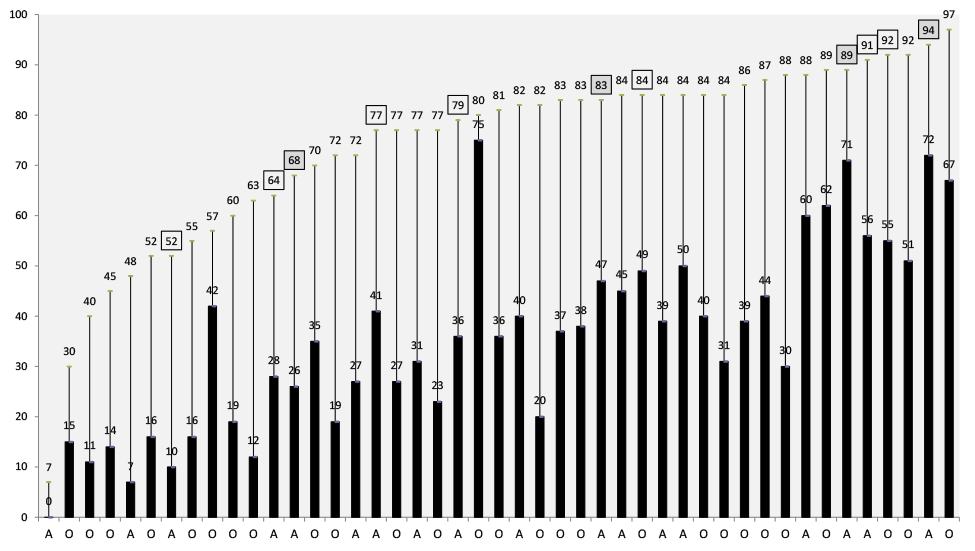 Legend: *Note: N=45 of 61 states (includes unique states); All students=18 states, Students without disabilities=27 states, No data=16 states Figure 21. Percent Proficient for High School Mathematics* 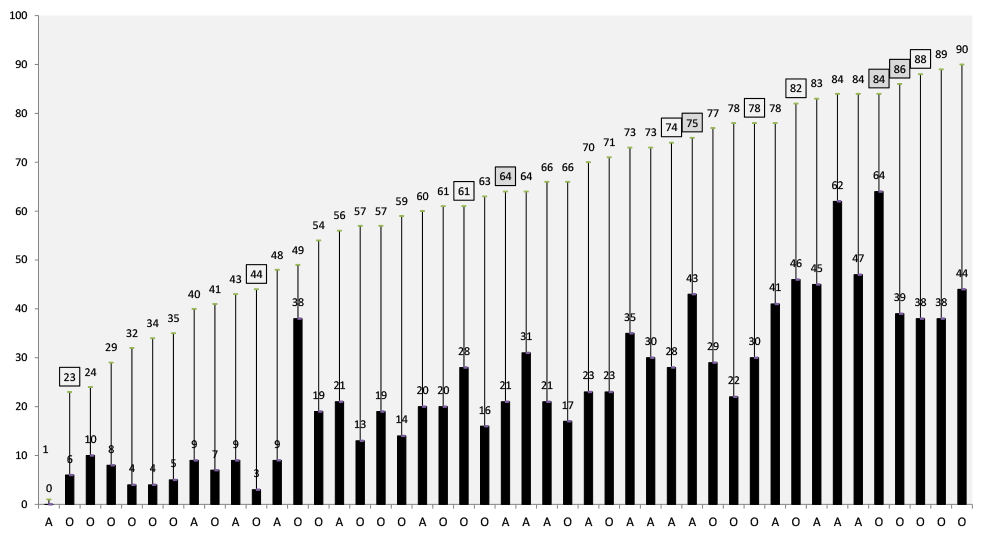 Legend: *Note: N=45 of 61 states (includes unique states); All students=18 states, Students without disabilities=27 states, No data=16 states Average Gap Summaries by Content Area and School LevelTable 1 summarizes the average achievement gaps between students with disabilities and an "All" student group. The "All" student group may or may not include students with disabilities depending on the reporting practices of each state. The table presents gaps by content and school levels across select years. A limitation of this analysis is that the number of states with data fluctuates from year to year and there are differences in how states report percent proficient for students with disabilities. For example, in some cases, states reported AA-MAS performance merged with general assessment performance. Table 1 shows the mean gaps for every other year from 2006-2007 through 2010-11. The table also shows the one-year mean gap between 2010-11 and 2011-12. The average gap is presented with the number of states with data for each year. The gap sizes changed only slightly across grades and content areas in these data. For example, for elementary reading, the mean gap was 31 in 2006-07 and 2008-09, 34 in 2010-11, and 33 in 2011-12. Table 1. Gaps Between Students with Disabilities and General Education Students on General Assessments: 2006-07 to 2011-12
Ease of Finding Publicly Reported DataPublicly reported data for students with disabilities is easier to find on some state websites than on others. An analysis was conducted of the number of mouse clicks it takes to arrive at public reports for the general assessment and the AA-AAS on state department of education websites. This analysis is similar to analyses in previous reports. The number of mouse clicks for each state did not take into account any potential short cuts through search engines that may have provided a link to parts of a state's education website. As in previous analyses, we did not count the additional clicks needed to choose specific demographic or assessment characteristics on sites that allowed users to generate customized reports. For those sites, we only counted the number of clicks needed to arrive at the generator site and a final "submit" click. This analysis was referred to as a "click" analysis in some previous reports. Click data for general assessments are presented in Figure 22, and data for AA-AAS is presented in Figure 23. Compared to the most recent year for this analysis (2010-2011), the number of states that required 7 clicks increased from none to one state for 2011-12, states with 5-6 clicks (N=13) increased by one, the number of states with 3-4 clicks decreased from 33 to 30, and the number of states with 1-2 clicks decreased by one state. For the AA-AAS, there was a general shift in states toward more clicks in 2011-12, with 1 less state in the 1-2 click category, 2 additional states in the 3-4 click category, an increase from 15 to 17 states in the 5-6 click category, and the addition of one state in the 7 click category where there were none in the previous analysis. Figure 22. Number of States in Each "Click" Category for States Reporting General Assessments for Regular States (N=49 of 50 States)
Figure 23. Number of States in Each Click Category for states Reporting AA-AAS (Total N=47 of 50 States)
Top of Page | Table of Contents Summary and ConclusionsExtent of Public Reporting for Students with DisabilitiesAll regular states, and most unique states, reported participation and performance for all general assessments and alternate assessments based on alternate achievement standards (AA-AAS) used for ESEA accountability purposes. Forty-nine of the 61 states reported both participation and performance for all general assessments; 51 reported similar data for the AA-AAS. Of the 16 states with general assessments outside ESEA, only 9 states reported participation and performance and 3 additional states reported participation or performance for some general assessments. This is an improvement from the previous report, where only 4 states reported participation and performance for all general assessments outside ESEA (22 states). An additional 10 states reported either participation or performance data, but not both. Extent of Public Reporting for ELLs with DisabilitiesThe number of states that reported both participation and performance for ELLs with disabilities increased by three states. In 2010-11 only four states reported both participation and performance data for ELLs with disabilities, while in 2011-12 seven states reported these data. For AA-AAS, more states (N=21) reported participation and performance. This number increased by one over the previous two years of data. It might be expected that more states would have reported disaggregated data for this assessment, given the requirements of ESEA to report by subgroup for each state assessment. How Data Are ReportedStates' most common approaches for communicating participation and performance on general assessments and AA-AAS remained the same in 2008-09, 2010-11, and 2011-12. For participation, the most common way to report was in terms of the number assessed (37 states for the general assessment) and percent participating (also 36 states) for 2011-12. For performance, the most common way was reporting the percent of students in each achievement level (39 states for general assessments) followed by percent proficient (34 states for general assessments). Because states used different methods to report (e.g., merging assessments, grades, or both), the numerators and denominators used to report participation and performance data varied significantly across states. Adding to the complexity is the fact that some states report public data using multiple methods across participation and performance, thus increasing the difficulty of making interpretations about participation and performance. As in previous reports, this report presented participation rates for middle school mathematics as an example of how states report participation rates for students with disabilities. Sixteen states reported participation rates by grade for at least one test (additional states provide numbers that would possibly allow for rates to be calculated). In recent years reported participation data have become less transparent, in part because states that had alternate assessments based on modified achievement standards sometimes opted to merge those data with the general assessment data in public reporting for participation and performance. Most states with an AA-MAS did not report participation rates for the AA-MAS separately, though a few did. Another reason that rates may be less straightforward is that states vary in the denominators used to calculate rates. Achievement GapsThe achievement gaps between students with and without disabilities in reading and mathematics persist. This report presented average achievement gaps for elementary, middle, and high school levels. As in past reports, there were smaller overall gaps in elementary reading and mathematics than at the middle school and high school levels. At the middle school and high school levels, for reading and mathematics, the average gaps across states spanned from 37% to 40%. Because states vary in the methods they use to publicly report data, this influences the achievement gaps reported. As would be expected, those states with "all students" as the comparison group tended to show smaller gaps compared to states using "all students without IEPs" as the comparison group. Other factors that influence the size of achievement gaps include whether a state has an AA-MAS, the percentage of students taking an AA-MAS in lieu of the general assessment, and how these data are reported. Ease of Finding Data on State WebsitesState websites vary in the ease of use in finding data about the participation and performance of students with disabilities. This report showed a slight reversal in the trend toward greater ease in recent years. In general it took more clicks overall in 2011-12 compared to 2010-11 to reach data for both the general assessment and the AA-AAS. Still, for the majority of states it took only 3 to 4 clicks to locate assessment data both for the general assessment (30 states) and AA-AAS (26 states). Recommendations for ReportingAs many states transition to new assessments based on common core standards, there may be changes in how performance and participation data for students with disabilities and ELLs with disabilities are reported. In the intervening time, it is important that states continue to publicly report data for students with disabilities with the same frequency and detail as for other students. As in the previous report (Albus & Thurlow, 2013), the following recommendations are offered for public reporting of disaggregated data for students with disabilities:
Top of Page | Table of Contents ReferencesAlbus, D., & Thurlow, M. (2013). 2010-11 publicly reported assessment results for students with disabilities and ELLs with disabilities (Technical Report 68). Minneapolis, MN: University of Minnesota, National Center on Educational Outcomes. Albus, D., Thurlow, M., & Bremer, C. (2009). Achieving transparency in the public reporting of 2006-2007 assessment results (Technical Report 53). Minneapolis, MN: University of Minnesota, National Center on Educational Outcomes. Klein, J. A., Wiley, H. I., & Thurlow, M. L. (2006). Uneven transparency: NCLB tests take precedence in public assessment reporting for students with disabilities (Technical Report 43). Minneapolis, MN: University of Minnesota, National Center on Educational Outcomes. Thurlow, M., Bremer, C., & Albus, D. (2008). Good news bad news in disaggregated subgroup reporting to the public on 2005-2006 assessment results (Technical Report 52). Minneapolis, MN: University of Minnesota, National Center on Educational Outcomes. Thurlow, M. L., Bremer, C., & Albus, D. (2011). 2008-09 publicly reported assessment results for students with disabilities and ELLs with disabilities (Technical Report 59). Minneapolis, MN: University of Minnesota, National Center on Educational Outcomes. Thurlow, M. L., & Wiley, H. I. (2004). Almost there in public reporting of assessment results for students with disabilities (Technical Report 39). Minneapolis, MN: University of Minnesota, National Center on Educational Outcomes. Thurlow, M. L., Wiley, H. I., & Bielinski, J. (2003). Going public: What 2000-2001 reports tell us about the performance of students with disabilities (Technical Report 35). Minneapolis, MN: University of Minnesota, National Center on Educational Outcomes. VanGetson, G. R., & Thurlow, M. L. (2007). Nearing the target in disaggregated subgroup reporting to the public on 2004-2005 assessment results (Technical Report 46). Minneapolis, MN: University of Minnesota, National Center on Educational Outcomes. US Department of Education (2013). ESEA flexibility: Frequently asked questions addendum. Washington, DC: author. Wiley, H. I., Thurlow, M. L., & Klein, J. A. (2005). Steady progress: State public reporting practices for students with disabilities after the first year of NCLB (2002-2003) (Technical Report 40). Minneapolis, MN: University of Minnesota, National Center on Educational Outcomes. Top of Page | Table of Contents Appendix AMaterial Used for the Verification ProcessExample letter to Assessment Director and Special Education Director.Dear ________, The National Center on Educational Outcomes is examining states' public reports for 2011-2012 school year assessment results. Our goal is to:
As in previous years, we are looking at assessment department reports and the equivalent of report cards used for ESEA. We have reviewed your Web site for this information and have enclosed tables summarizing that review. Please verify all included information. Specifically, please return the tables that we have attached, noting your changes to them. Also, if there is additional publicly reported information available for your state, please provide us with the public document and/or website that contains the information. Address your responses to Deb Albus via email albus001@umn.edu. If you have any questions about our request, please email Deb Albus or call at (612) 626-0323. Please respond by July 26, 2013. Thank you for taking the time to provide this information. Martha Thurlow, Director NCEO Deb Albus, Research Fellow, NCEO
Example Verification Tables Sent to a StateALL DATA for 2011-2012 Participation and Performance Data for Students with Disabilities, Regular and Alternate Assessments Based on Alternative Achievement Standards (AA-AAS) Table 1. Data for All Students with Disabilities
Table 2. Data for ELLs with Disabilities
How States Reported Participation Data for Students with Disabilities for Regular Assessments (In ESEA)Table 3. Ways States Disaggregated Participation Rate
Table 4. How Participation was Reported
How States Reported Performance Data for Students with Disabilities for Regular Assessments (In ESEA)Table 5. Ways States Disaggregated Performance Data
Table 6. How Performance was Reported
How States Reported Participation and Performance Data for AA-AAS (In ESEA)Table 7. How Participation was Reported
Table 8. How Performance was Reported
Accommodations Data, for Regular AssessmentsTable 9. Populations for Which States Reported Accommodations Data
Table 10. Number of States Reporting Different Accommodation Status Categories for Any Population
Table 11. Number of States Reporting Participation and Performance by Accommodated Condition for Any Student Population
Appendix BData Tables |
||||||||||||||||||||||||||||||||||||||||||||||||||||||||||||||||||||||||||||||||||||||||||||||||||||||||||||||||||||||||||||||||||||||||||||||||||||||||||||||||||||||||||||||||||||||||||||||||||||||||||||||||||||||||||||||||||||||||||||||||||||||||||||||||||||||||||||||||||||||||||||||||||||||||||||||||||||||||||||||||||||||||||||||||||||||||||||||||||||||||||




